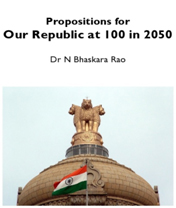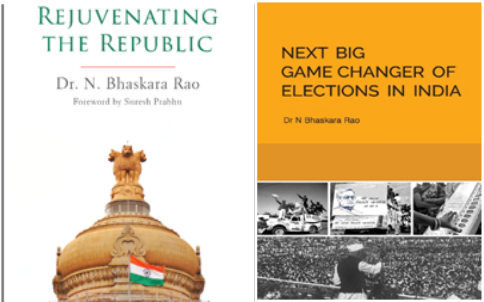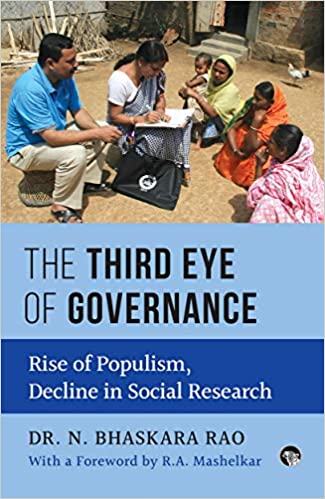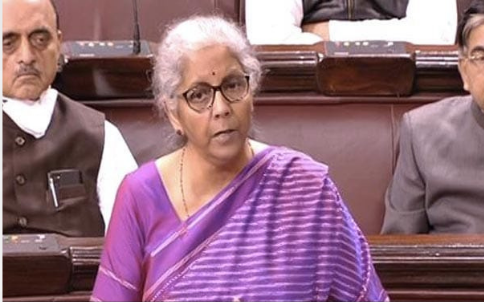Kudos to Prime Minister Modi and Finance Minister Sitharaman for referring to next 25 years in the budget as Amrit Kaal claiming blueprint for “India at 100” for centenary year of 2047. However there is no reference to how this is going to be accomplished particularly since physical growth plan alone is not good enough as the development story of the past 75 years amply indicates. Since then, the Prime Minister promised in his election speech few days ago at Meerut that elections are fought to “ensure permanent peace”. Exactly a year ago, I published “Propositions for our Republic at 100 in 2050”, where in I suggested issues without considering of these next 25 years, no big change could be expected. What are those suggestions and why I said these changes are prerequisite for achieving? What we could not achieve with 17 general elections, will we in the next six general elections?
How to accomplish Amrit Kaal?

Now that the idea of “India at 100” has been abruptly referred to as a part of the budget presentation in parliament last week it is important that 2022 witnesses public discourse on what that process should involve and how we could accomplish Amrit Kaal by 2047. The concern for Amrit Kaal should be not limited to 25 years and limited to growth targets in physical terms but years much beyond. The six general elections the country is going to have next 25 years should differentiate for charting the country to such a course and by that period. Three of my recent books in 2021 focus exactly on such concerns. These books are sequential and remind of essential elements that sustain democracy, uphold the Republic and ensure good governance or unleash Amrit Kaal. All these three books as my other books are available on Amazon.
“The Third Eye of Governance” is first ever book on data, statistics, research, and evaluation as independent instruments of growth, performance, accomplishments and being made. It suggests these as essential for making checks and balance. It brings out how a quantitative support has been on decline with control and command approach of leaders over shadowing the ground realities. Doyen of innovations and industrial research in India, Dr R A Mashelkar brings out in his foreword the significance of the book lucidly.
Also read: Rejuvenating villages by bringing children and women to the forefront
“The Rejuvenating the Republic”, the second book, suggests measures so that by 2050 when the Republic becomes 100 years, we catch up with goals set and envisioned in the constitution for the trajectory of development, democracy and governance. Former Union Minister who held several portfolios over the decades, Suresh Prabhu, brings out the timeliness of the book in his foreword and considers it a valuable input for much needed public discourse for Rejuvenating the Republic.
“Next Big Game Changer of Elections in India” is the first book to analyze poll campaigns as origin and source for all the ills being faced in the country. And, contends that without these correctives, future is not going to be any different or better. The book suggests alternative options for a collaborative way of contests and campaigns. It even suggests polls without party symbols so that the focus shifts to candidates. Nalapat, UNESCO professor, in his foreword reminds urgency of changes in our electoral practices.
Also read: Have we failed as a Republic or is it a ‘glass half empty’ situation?

These books along with my other books on Good Governance, Citizen Activism, etc. over the years not only review, analyze and diagnose but also offer an independent perspective for an inclusive and participative development, and offers specific interventions and correctives. Most of these do not require any constitutional amendments, and can be taken up. Many of them in fact were also suggested earlier by one or other panel. These books contend that three pillars view of the state has outlived. For an inclusive and holistic growth, press, civil society and political parties should be brought under a regime. They should function in a checks and balance framework and in a State of equilibrium.
Also read: Role and responsibility of media in 21st century
The three books remind the provision of “checks and balance” in the constitution and its significance. This feature is not possible without institutions upholding their independence and credibility. The Third Eye idea of governance is for the pillars to be in their limits data, statics, feedback, research and evaluation methodologies and institutions should be independent. Another feature reminded in the three books is transparency in the functioning of pillars of the government including the political parties, media of public communication in particular.

Each of these books describes the trends with narration of little known facts as examples. The Next Game Changer exposes, for example, multiple myths, duplicity and contradictions and offers an alternate model of electing peoples representatives. Together these books remind how the virtue of “We the People” republic has become a democracy of “We the Parties”. These books suggest compulsions for accomplishing much more in the next six general elections than what we did in the last 17 elections. And points to urgency of reversing some of the ongoing electoral trends with more sustainable approaches.
Role of citizen does not end with voting
The three books point that governance is not by the government alone but it consists of civil society. They remind that the role of citizen does not end with voting and reminds active and continuing concern of civil society, which includes the academics. They suggest viewing civil society as the “fifth pillar” of the Republic. Citizen activism on its own does not threaten or destabilize as often presumed by leaders in power but consolidates and sustains democracy. These books reiterate special role of mass media and their responsibility. Even with in the market compulsions, news media could revive their Fourth Estate stature. Both political parties and news media would be better off by coming under transparency regime as the other pillars of the state are. The three books remind emergence of political parties as dominant players determining and dictating everything else refusing to come under checks and balance system. Without their revenue and expenditure coming under regulation and political parties complied get their own constitution, can we expect them as responsible?
In order to achieve permanent peace…
In the ultimate analysis, good governance or Amrit Kaal, or even “permanent peace” in a parliamentary democracy is not possible without good politics. Good politics, in turn, is not possible without good political parties. And political parties cannot be concerned without responsible leaders. All this is not possible without truly free, fair and transparent elections, active citizenry and community participation in governance. Only when political parties and the governments frame public policies with a concern far beyond an immediate next election, we can expect to unleash Amrit Kaal. What do we propose to ensure this? Neither the Prime Minister nor the Finance Minister made any reference so far to any of these or such essential initiatives or correctives to accomplish Amrit Kaal.
***
(Dr. N. Bhaskara Rao is a longstanding research based public policy analyst in India)




